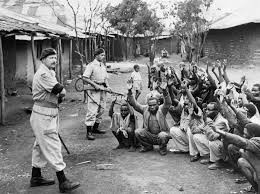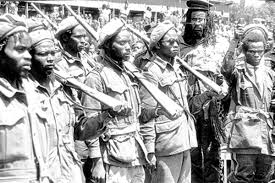Introduction
Have you ever wondered about the untold stories of Africa’s fight against colonial rule? One of the most remarkable is the Mau Mau Uprising, a rebellion that symbolized Kenya’s fierce struggle for freedom from British colonialism. Between 1952 and 1960, the Mau Mau movement galvanized thousands of Kenyans to challenge oppression, endure unimaginable hardships, and ultimately pave the way for independence. Let’s delve into this hidden history to uncover the sacrifices and resilience of those who fought for Kenya’s sovereignty.
Colonial Kenya: The Seeds of Discontent

The Impact of British Colonial Rule
British colonization in Kenya began in the late 19th century, with settlers seizing fertile lands and relegating indigenous populations to reserves. This displacement, coupled with discriminatory policies, ignited resentment among Kenyans.
The Kikuyu Land Question
The Kikuyu, one of Kenya’s largest ethnic groups, were particularly affected. Many lost ancestral lands to British settlers, leading to widespread poverty and frustration.
What Was the Mau Mau Uprising?
Origins of the Movement
The Mau Mau Uprising was a militant nationalist movement that sought to reclaim Kenyan land and independence. While it primarily involved the Kikuyu, other ethnic groups also participated.
Meaning of “Mau Mau”
The origin of the term “Mau Mau” is debated. Some suggest it was a British invention to demean the rebels, while others believe it symbolized resistance and unity.
The Oath of Unity
A Sacred Bond
To strengthen loyalty, Mau Mau members took secret oaths binding them to the cause. These oaths were deeply spiritual and rooted in Kikuyu traditions, emphasizing unity and sacrifice.
Misrepresentation by Colonists
Colonial authorities depicted these oaths as barbaric, using this portrayal to justify harsh crackdowns on the movement.
The Armed Struggle
Guerilla Warfare

Mau Mau fighters adopted guerilla tactics, launching surprise attacks on British installations, settlers, and collaborators. They operated mainly from the forests of the Aberdare Range and Mount Kenya.
British Countermeasures
In response, the British declared a state of emergency in 1952. They deployed military forces and established detention camps, intensifying the conflict.
Life in the Forests
Survival Against Odds
Mau Mau fighters endured harsh conditions in the forests, facing hunger, disease, and relentless British offensives. Despite these challenges, they remained committed to the cause.
Support from Villages
Many local communities risked their lives to supply Mau Mau fighters with food, information, and shelter, showcasing widespread solidarity.
The Role of Women in the Uprising
Female Fighters and Supporters
Women played a crucial role, acting as couriers, spies, and even combatants. They also maintained morale within the movement.
Silent Sacrifices
While often overshadowed in history, women endured brutal treatment in detention camps and villages, proving their unwavering dedication to Kenya’s liberation.
The British Response: Brutality and Suppression
Detention Camps
The British established a network of detention camps where suspected Mau Mau members were subjected to torture, forced labor, and inhumane conditions.
Villagization Policy
To isolate Mau Mau fighters, the British forcibly relocated Kikuyu communities into fortified villages, disrupting traditional lifestyles and causing widespread suffering.
The Role of Propaganda
Demonizing the Mau Mau
British propaganda portrayed the Mau Mau as savage and primitive, framing the rebellion as a tribal uprising rather than a legitimate struggle for independence.
Counter-Narratives
Despite these efforts, Mau Mau leaders like Dedan Kimathi inspired many through their vision of a free and united Kenya.
The End of the Uprising
Decline of the Movement
By the late 1950s, the Mau Mau’s strength waned due to military defeats, internal divisions, and dwindling resources.
The Legacy of Resistance
Although the uprising was suppressed, it intensified demands for independence, forcing Britain to reconsider its colonial policies.
Kenya’s Path to Independence
The Lancaster House Conferences
In the early 1960s, negotiations between Kenyan leaders and British officials culminated in the Lancaster House Conferences, which laid the groundwork for independence.
Independence Achieved
On December 12, 1963, Kenya gained independence, with Jomo Kenyatta, who had been imprisoned during the uprising, becoming the first president.
Also Read: The Wealthy Elite: A Look at Africa’s Richest Families
The Legacy of the Mau Mau Uprising
Recognition of Sacrifice
The Mau Mau rebellion is now recognized as a cornerstone of Kenya’s liberation struggle, symbolizing the resilience and courage of its people.
Post-Independence Challenges
Despite achieving independence, Kenya faced challenges in addressing the injustices of colonialism, including land redistribution and national unity.
Lessons from the Mau Mau Uprising
Unity in Resistance
The Mau Mau demonstrated the power of unity in confronting oppression, a lesson that resonates in struggles for justice worldwide.
The Cost of Freedom
Their story reminds us that the path to freedom often demands immense sacrifices, leaving a lasting impact on future generations.
Honoring the Mau Mau Today
Memorials and Recognition
Kenya has erected monuments and held ceremonies to honor Mau Mau fighters, ensuring their contributions are not forgotten.
Continued Reconciliation
Efforts to address the historical injustices of the colonial era continue, fostering healing and national cohesion.
Conclusion
The Mau Mau Uprising was more than a rebellion; it was a defining moment in Kenya’s history. The fighters’ courage, sacrifices, and determination against overwhelming odds exemplify the human spirit’s resilience. As Kenya continues to grow as a nation, the legacy of the Mau Mau serves as a reminder of the hard-fought journey to freedom and the enduring importance of justice and unity.
Also Read: How To Make Money Online for Beginners: 10 Easy Ideas 2024
FAQs
1. What was the Mau Mau Uprising?
The Mau Mau Uprising was a Kenyan rebellion against British colonial rule from 1952 to 1960. It aimed to reclaim land and secure independence.
2. Who were the Mau Mau fighters?
The Mau Mau fighters were primarily members of the Kikuyu ethnic group, along with other supporters, who resisted British colonialism through armed struggle.
3. What was the British response to the Mau Mau?
The British declared a state of emergency, used military force, established detention camps, and implemented harsh policies to suppress the rebellion.
4. What role did women play in the uprising?
Women acted as couriers, spies, and combatants, while also providing logistical support and enduring brutal treatment in detention camps.
5. Why is the Mau Mau Uprising important?
The uprising was pivotal in Kenya’s fight for independence, highlighting the sacrifices made by its people and shaping the nation’s post-colonial identity.


